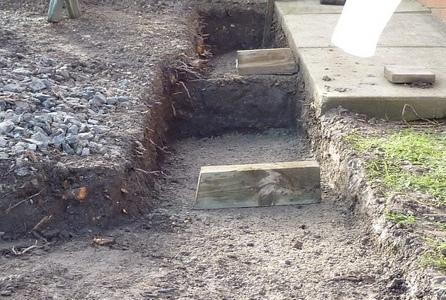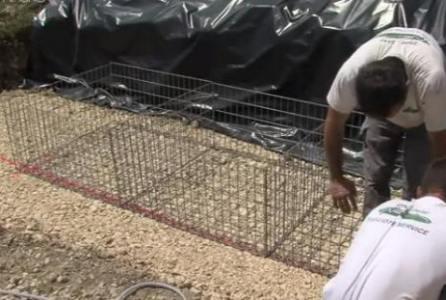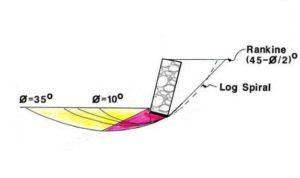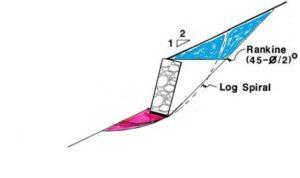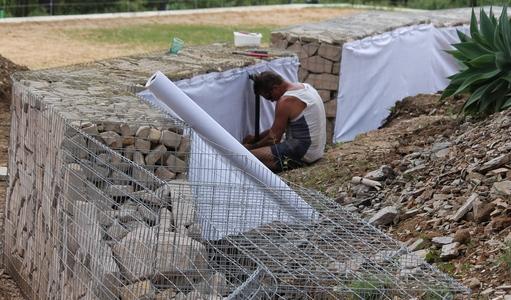
Filter Fabric Use
Geotech filter fabric stops fine silts and clay migrating into the wall.
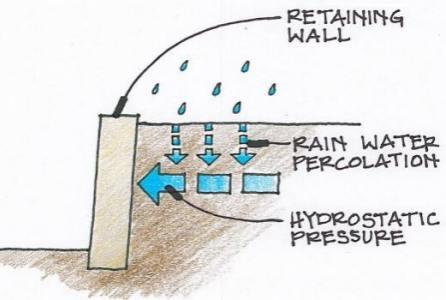
Gabion Drainage
Gabion retaining walls need adequate drainage.

Small Gabion Walls
Walls under 3ft tall, with flat ground behind, you can place the soil against the gabion.
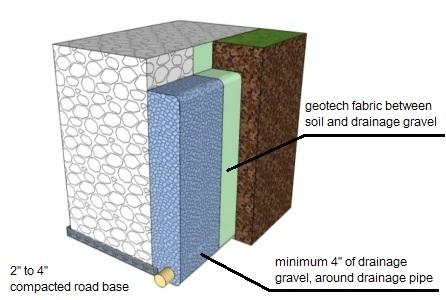
Gabion Walls over 3ft
Larger walls have greater loads on them. It is recommended the drainage gravel be placed near the top.
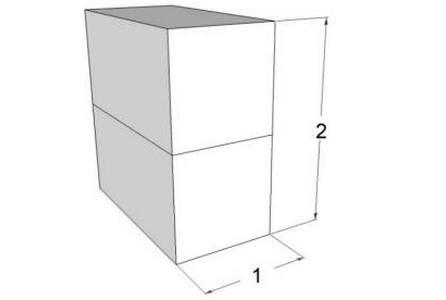
Gabion retaining walls 2:1 stability
Gabion walls that are narrower than this ratio are not suitable for retaining applications.
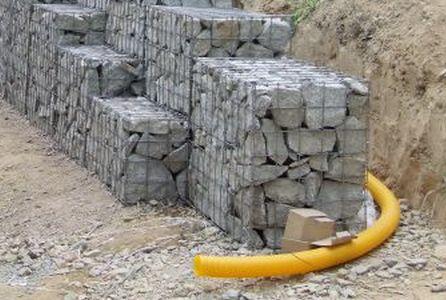
4″ diameter jettable drainage pipe
The drainage pipe is often encased in a filter sock, to prevent silts and clay clogging up the pipe.
Gabion wall design considerations
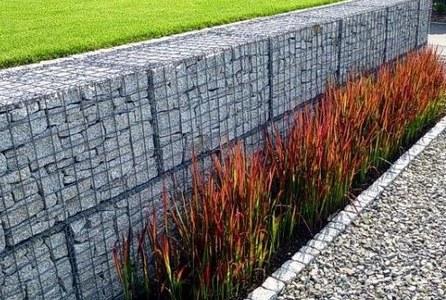
Walls under 5' tall
Small gabion walls built to a 2:1 ratio can be built vertical and still pass standard overturning calculations.
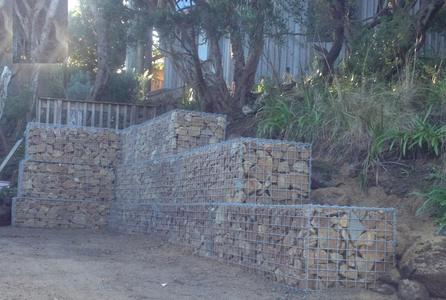
Complex wall designs
Large walls with slopes or buildings above need a engineer's design as the simple 2:1 ratio no longer applies.
Retaining wall profiles and design factors
Design notes:
The retaining wall toe prevents the gabion wall sliding forwards, the depth of the toe needs to increase as the wall gets bigger. When building gabions on softer soils, both the depth of the toe and the size of the base needs to be increased to spread the load over a wider area. An engineer’s design will consider design limit states and specify the dimensions of the toe and base for your wall.
Any excavations should be checked for any flows or seepage that require drainage measures. Any flows, seepage or standing water should be directed to a suitable outfall as soon as they are encountered. The wall drainage must be inspected and maintained (rodded/jetted) annually and after particularly heavy rainfall events. This is essential to prevent the pore water pressures increasing behind any retaining wall.
For larger retaining walls and difficult sites, it is recommended that a soil investigation is undertaken and that the wall is designed by a qualified geotechnical engineer.
If a safety fence or barrier is placed along the top of a gabion wall, to prevent falls. It is assumed that this fence will be post and mesh, or open boarded, so as to not add any wind or impact loads to the gabion structure. Possible wind and impact loads need to be considered and the design revised to accommodate these loads on the gabion retaining wall.
Temporary excavations have the potential to collapse rapidly and without warning, and may become unstable during wet weather. Contractors should plan their work to reduce this risk of collapse and consider the use of temporary propping during construction.
No liability is accepted where a typical section is used as a the basis for the final design. The suggested details provided are guidelines only for budget purposes.
It is assumed that any building foundations on the retained side of the walls will be taken to such as level so as to ensure that no loads are transferred to the Gabions or backfill. The building
foundations must not rely on the Gabions or for support, and are outside the scope of simple designs for budget purposes.
When the gabion retaining wall is subjected to a additional surcharges, from a driveway or other loads, the designer will most likely increase the thickness of the gabions, to handle the higher expected loads.
Most gabion retaining walls can be built on soils with a minimum bearing capacity of 100Kpa. Any soft, loose, organic or unsuitable material must be removed and replaced with compacted granular fill.
When constructing gabion retaining walls in strongly acidic soils(PH over 5.5), the soil and the corrosive groundwater must be separated from the gabion structure by using geotextile fabrics and a properly designed drainage system.
For advice or assistance with the design of an economical gabion wall, please email our engineer@gabion1.com
INTERESTING LINKS
Here are some interesting links for you! Enjoy your stay :)
PAGES
- 1.5:1 Gabion baskets
- 1.5:1 Gabion baskets under 4′
- 10 things you need to know about gabions
- 2:1 Gabion baskets
- 2:1 Gabion baskets under 4′
- 3:1 Gabion baskets, support posts required
- 4:1 Gabion baskets, support posts required
- Bridge buttress protection with gabions
- Cart
- Cart2
- Checkout
- Checkout
- Contact Us
- Custom Size and Pricing Form
- Gabion Assembly Shuttering
- Gabion Basket Curved Wall Examples
- Gabion Basket Curved Wall How To
- Gabion Basket Design Life Chart
- Gabion Basket Furniture
- Gabion Basket Information-Adw
- Gabion Basket Information-g-disp-h-h-garden
- Gabion Basket Information-g-disp-h-h-home
- Gabion Basket Information-g-disp-h-h-improve
- Gabion Basket Information-g-disp-h-h-making
- Gabion Basket Information-g-disp-h-h-yard
- Gabion Basket Information-g-rem-desk
- Gabion Basket Information-g-rem-m
- Gabion Basket Information-g-rem-m1
- Gabion Basket Information-m35
- Gabion Basket Information-m45
- Gabion Basket Information-m55
- Gabion Basket Information-m65
- Gabion Basket Information-Pin-pro
- Gabion Basket Information-pinterest
- Gabion Basket Information-w35
- Gabion Basket Information-w55
- Gabion baskets under 4′ tall
- Gabion component prices
- Gabion corten corner assembly information
- Gabion Cube baskets
- Gabion Diaphragm
- Gabion Erosion Control
- Gabion erosion wall
- Gabion Fence with timber
- Gabion foot bridge
- Gabion Foundations
- Gabion how to videos
- Gabion Information-Pin-1
- Gabion Information-Pin-11
- Gabion Information-Pin-12
- Gabion Information-pin-13
- Gabion Information-Pin-14
- Gabion Information-Pin-4
- Gabion Information-Pin-6
- Gabion Information-Pin-7
- Gabion Information-Pin-8
- Gabion lake jetty
- Gabion Landscaping Ideas
- Gabion Mail Box
- Gabion mesh repairs
- Gabion Partition Wall
- Gabion Patio Wall
- Gabion pipe culvert protection
- Gabion Pizza Oven Bases m35-ca
- Gabion Pizza Oven Bases m45-ca
- Gabion Pizza Oven Bases m55-ca
- Gabion Pizza Oven Bases m65-ca
- Gabion Pizza Oven Bases w35-ca
- Gabion Pizza Oven Bases w55-ca
- Gabion Pizza Oven Bases-Construction
- Gabion Railway Ballast
- Gabion retaining small flowers
- Gabion retaining wall brick bond
- Gabion Retaining Wall Design Guidelines
- Gabion retaining wall offset
- Gabion retaining wall on slope
- Gabion retaining wall with steps
- Gabion Retaining Walls
- Gabion Retaining Walls AL1
- Gabion Retaining Walls-1
- Gabion river crossing
- Gabion Rock Size
- Gabion Seating Construction Details-1
- Gabion Seating Construction Details-2
- Gabion Seating Construction Details-3
- Gabion Seating Construction Details-4
- Gabion Seating Construction Details-5
- Gabion Seating Construction Details-6
- Gabion Seating Construction Details-7
- Gabion Seating Construction Details-8
- Gabion Seating Construction Details-9
- Gabion Seating Idea
- Gabion Step Options
- Gabion Stone Fences
- Gabion Wall
- Gabion wall stability guidelines
- Gabion wall under 4′ tall
- Gabion wall with night lights
- Gabion Wall with seat
- Gabion weir layout
- Gabion Wire Mesh Size Information
- Gabion1 Outdoor Dining Table
- Garden brick wall design
- Garden Stone Wall Design
- Homepage
- How to order and buy your gabions
- Kitset Gabion Prices
- Kitset Retaining Wall Gabion Prices under 4′ tall
- Large gabion erosion wall
- My Account
- Payment Credit Card
- Payment Error
- Payment Thankyou
- Phone Us
- Product help
- Product Inquiry
- River bank conservation
- River bank preservation
- River Bank Protection
- River bank stabilization
- Shop
- Small gabion erosion wall
- Square gabions
CATEGORIES
ARCHIVE
